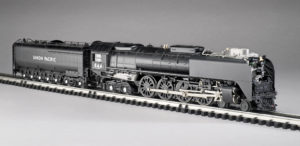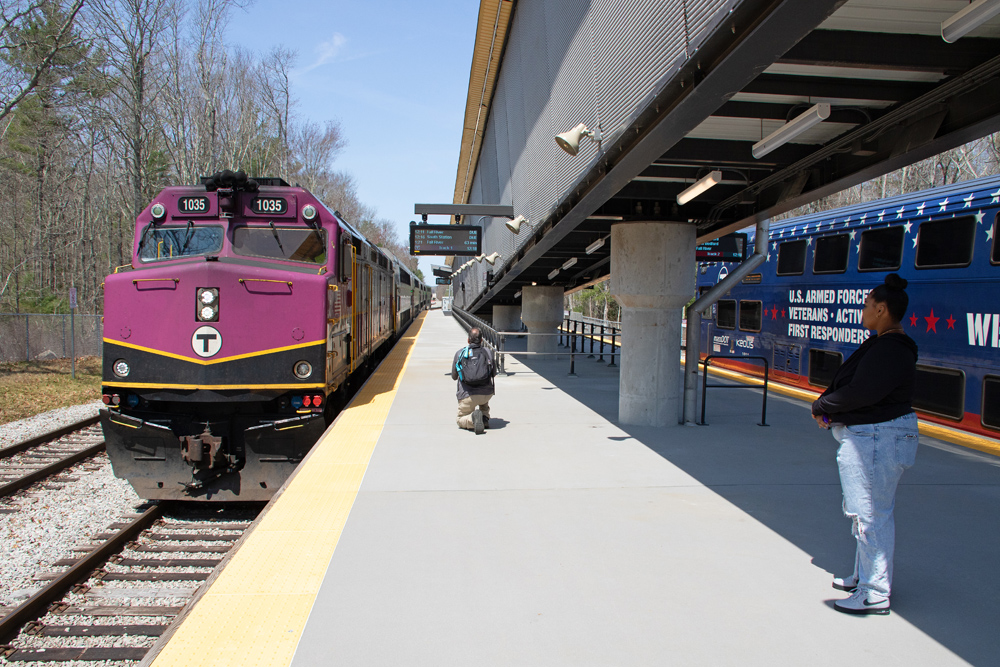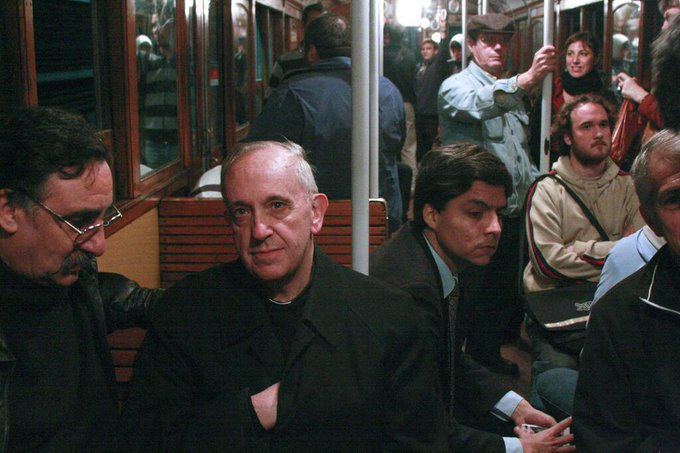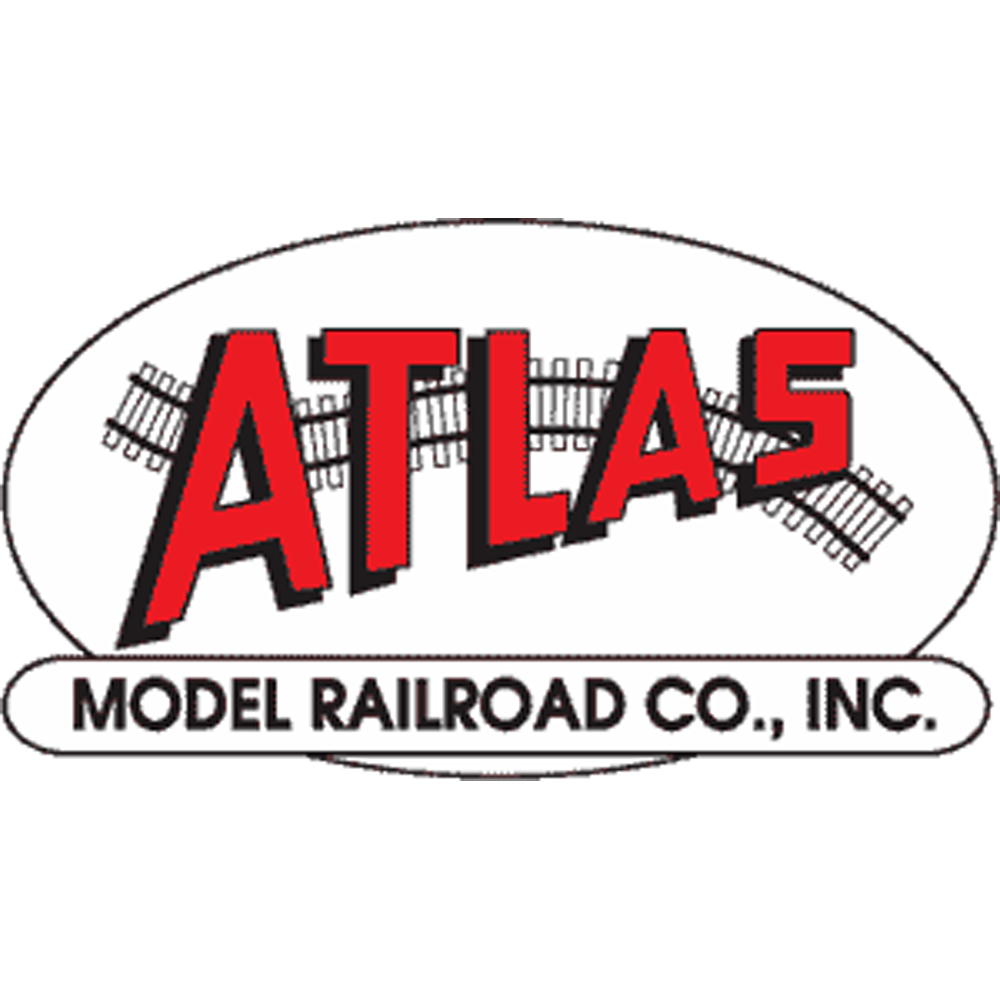
LET’S CUT RIGHT TO THE CHASE.
This is the finest steam locomotive that Lionel has ever made. Period. End of discussion. Insert photo of me puckering up to give this steamer a big old smooch. Whew. OK, I’ve taken a deep breath. I’ve cooled down. Now, on with the rest of the review.
This Lionel product models one of the iconic images of the steam era – but this model became an icon simply because it has been the key breadwinner of the Union Pacific steam program since the 1950s.
Thousands of people who’ve never had the chance to see big, live, operating steam in its natural habitat have witnessed this giant of the rails running excursions. Therefore, the 844 (also once operating under the number 8444) has become their main reference for what steam power was all about.
But what about the prototype locomotive?
Somewhat surprisingly, in the middle of the Great Depression, the Union Pacific was encountering trouble meeting the demand for high-speed passenger service. The 700-series 4-8-2s were at their peak, and they were having trouble handling 20- and 22-car Pullman trains.
To fix this problem, the railroad considered a new design, and typical of the way the UP did business, the new class of 4-8-4s had all the latest bells and whistles. The first of the 800s (class FEF-1, engines 800-819) entered service in 1937, and the 20 locomotives in that group racked up more than 3.5 million miles in fast passenger service in their first year. That tally worked out to nearly 15,000 miles per month for each of the 4-8-4s, and an impressive in-service rate of 93 percent.
In 1939, a larger class (FEF-2, engines 820-834) entered service, with 80-inch drivers, a large boiler, an all-weather cab, and 14-wheel centipede tenders.
The final 4-8-4s ordered by the UP arrived in 1944 (FEF-3, nos. 835-844) and were nearly identical to the FEF-2 locomotives, save for a Commonwealth cast-steel pilot and twin smokestacks surrounded by a streamlined casting.
Throughout their service life, the UP’s FEFs delivered top-flight service at speeds that today might be considered illegal. Indeed, after diesel and turbine power had the upper hand, the Northerns were stored in operable condition for traffic surges.
Four UP 4-8-4s survive today, two on public display and two owned by the Union Pacific (844 in service and 838 as a parts donor for 844).
The locomotive our sample models, no. 844, has been a stalwart of the Union Pacific’s steam program since the 1960s.
Opening the box
Lionel does “big and heavy” well, and this O gauge model proves it can also do dainty and detailed. The locomotive’s pilot and smokebox face combine big and industrial, as well as finely detailed, features in a single model.
The pilot looks thick and massive – like it could T-bone a Greyhound bus and keep on rolling. Brake lines feed through the slats in the pilot. On top of the pilot deck you’ll find an uncoupler arm and four tiny conduit lines emerging from the compressor shield and running below the deck.
Handrails rise up from the front and proceed along the boiler, and the face is very busy with markers, train boards, a headlight and warning lights, a bell, number boards bracketing the headlight, and the famed UP shield. A care and feeding note: the train number boards bend easily, so handle with care!
Note: The upper warning light lens should be red, not clear. If you bought an FEF and this bothers you, contact Lionel’s Service Department for a red lens to replace the clear part.
The smoke deflectors dominate the nose of the locomotive, running just more than 5 inches in length. The supports for the devices arc gently over to the boiler. The twin smokestacks, surrounded by a streamlined casing, are standout items. You’ll find a gold-toned whistle just behind the stacks. Like the pop-off valves, the whistle has a red-painted valve handle.
The real FEF has a smooth, uncluttered look to its boiler, and the model is true to this design. The boiler casting is clear and clean, yet possesses rivet detail and plenty of reference points, such as boiler bands, hatch covers, and top seams. I particularly liked the lines of cast-in rivet heads below the add-on reverse line.
The long sand dome has two grab irons on each side. An add-on turbine is located on the fireman’s side of the boiler. The walkways don’t have safety tread, but they are semi-perforated, suggesting rain drain holes.
The cab is totally enclosed (and has two windows at the back of the bulkhead), with crew figures and opening side windows. The roof hatch also opens. The front windows are cast-in, but they have three tiny view ports.
Flip the cab over, and beneath the firebox you’ll find run/program and speed control switches on the engineer’s side.
The drive wheels seem rugged, and the naturally colored silver-gray metal side rods look striking.
The tender is a 14-wheel, oil-burning centipede, with two axles in a free-moving truck and 10 wheels in a rigid frame. Topside, you’ll find handrails. The oil hatch doesn’t open, but it does have some nice latch and hinge detail. The three water hatches can be raised, with one hiding a RailSounds/SignalSounds switch and another concealing a volume control.
The die-cast metal shell houses the systems speaker, and the tender mounts a coil coupler on the rear. Ladders run up both sides of the tender’s rear, and there are three lights mounted along the top. Add-on drain lines (two on the engineer’s side and one larger pipe on the fireman’s side) run just above the wheel frames.
Painting and decoration of this Lionel steamer are first-rate. A nice satin black finish distinguishes most of the model, with graphite gray on the smokebox and firebox. Silver is used for the numbers, nomenclature, and Union Pacific road name.
This O gauge model is a superbly crafted, die-cast metal model of the prototype, but its performance is what really sets it a notch or three ahead of anything Lionel has previously offered.
On the test track
This is our first Legacy steam locomotive, and the changes in electronics really pay off for this model. Try as hardas it might, the weak spot with modern Lionel locomotion has been a lack of totally smooth movement at the lowest speeds. The development of the Odyssey speed control system was a slight improvement, but virtually all Odyssey-equipped locomotives we tested had a lurch – the only question was, “How bad is it going to be?”
On some models the stuttering of the wheels was more noticeable than others. Watch long enough, and you’ll notice it – the only question was how obvious (or annoying) you find it.
But all in all, the FEF has the smoothest low-speed performance I’ve ever seen on a Lionel product.
As nice as the model looks, and impressive as the sound package is, the proof in the pudding is how the model moves. As the FEF slowly began to roll, I would have sworn it was the real locomotive – the movement that smooth.
How slow was it?
It was fall to the knees and get the eyeballs at track level to watch the rods syncopate and the wheels rotate kind of slow. To increase the speed, just nudge the CAB-2 throttle up a bit, and – Shazam! – instant, perfectly smooth acceleration.
Our low-speed test average was 2 scale miles per hour, while the high-speed average was 66 scale mph. I assure you it can go faster – but I dislike running $1,000 locomotives at high speeds through curves in a room with very hard floors!
Drawbar pull was an awesome 3 pounds, 8 ounces.
The locomotive has two power pickup rollers roughly 5 inches apart, and the tender has two rollers 4½ inches apart. Traction tires are located on the rear drivers.
A coil coupler is mounted on the tender, which is also equipped with Lionel’s wireless tether.
The sound is goose-pimple good. The locomotive’s chuffs are robust, and the whistle is terrific.
Factor in the gee-whiz ability of using Legacy’s sliding whistle control to ease the whistle blast on and off, and you’re talking big-time sound action. There is nothing bad about this sound package!
The FEF is the finest Lionel product I have ever seen or operated, and it casts a long shadow that will be tough for future Lionel steam releases to surpass. Even if you don’t buy an FEF, just watching this model in action is its own reward.
O GAUGE UNION PACIFIC FEF-3 4-8-4 BY LIONEL
Price: $1,159 (no. 11131)
Features: O-72 operation, can-style motor, die-cast metal construction, RailSounds and
Legacy systems, speed control, coil coupler
Staff comments: Lionel does not need to ever make another Union Pacific FEF. The firm achieves perfection with this model. – Bob; The state-of-the-art sound system alone is enough to make me consider selling off my fleet of diesels – even our brethren from Model Railroader magazine were awestruck! – Kent; Superb model of a famous prototype, but why did Lionel mount essential control switches under this locomotive? – Carl
Made in the People’s Republic of China for Lionel













